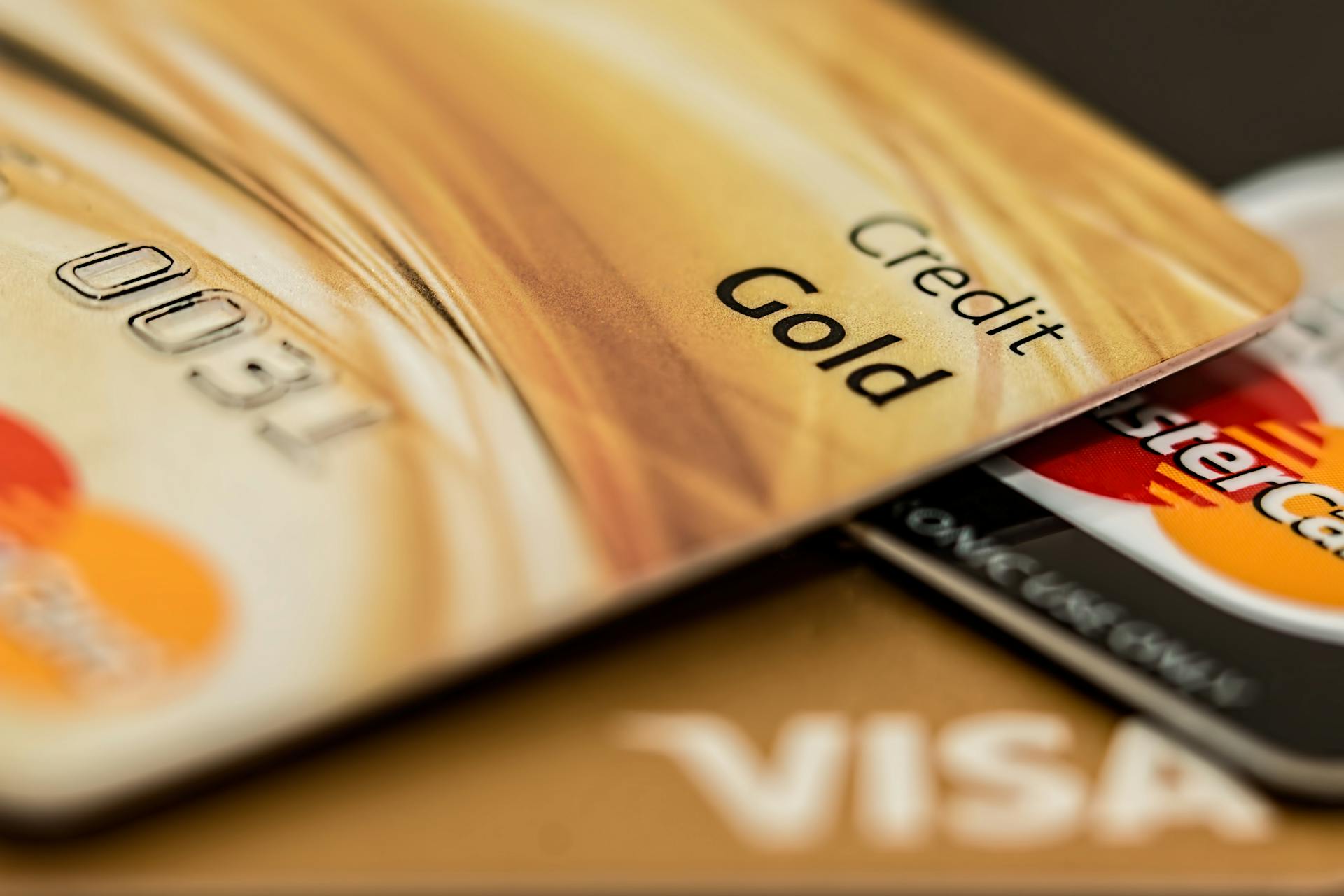
Managing debt in Canada can be overwhelming, but there is hope. According to the Financial Consumer Agency of Canada, over 12 million Canadians are living with debt, with the average debt load being around $22,000.
Debt consolidation is a popular solution, but it's essential to understand the process and its benefits. In Canada, debt consolidation typically involves combining multiple debts into one loan with a lower interest rate and a single monthly payment.
This can lead to significant savings, with some Canadians reducing their interest payments by up to 50% or more. By consolidating debt, individuals can also simplify their finances and avoid the stress of juggling multiple bills.
For Canadians struggling with debt, debt consolidation can be a lifeline.
Readers also liked: B of a Refi
Debt Consolidation Options
Debt consolidation options can help you simplify your finances and save on interest costs. A consumer proposal is a debt consolidation option that deals with almost all unsecured debts and results in one, single, lower monthly payment.
You can use a debt calculator to understand your debt consolidation options and the cost associated with each. If you're struggling to gain debt relief, you should speak to an experienced Licensed Insolvency Trustee to understand your debt consolidation options.
A credit card balance transfer can help you pay down your debt faster by moving existing high-interest credit card debt to a new balance transfer credit card with a lower interest rate. However, be mindful of balance transfer fees and ensure you can pay off the balance before the promotional period ends.
Personal loans can be used for debt consolidation and typically have fixed interest rates and repayment terms, making it easier to budget for monthly payments. A personal loan can be secured or unsecured.
A debt consolidation loan is specifically designed to combine multiple debts into one loan, often with a lower interest rate than your existing debts. You can pay off multiple creditors simultaneously, leaving you with a single loan to manage.
A line of credit (LOC) is a flexible borrowing option that allows you to withdraw funds up to a predetermined limit. With LOCs, you only pay interest on the amount you use.
You might like: How to Lower Credit Card Interest Rate Discover
Home equity loans are a popular option for debt consolidation, allowing you to borrow against the equity in your home, often at lower interest rates than credit cards. By consolidating debt through a home equity loan, you can simplify your payments and save on interest costs.
Here are some popular debt consolidation methods:
Understanding Debt Consolidation
Debt consolidation is a process that can help simplify your financial obligations and potentially save you money on interest.
You can consolidate various types of debt, including credit card debt, tax debt, payday loans, store cards, student loans, and medical bills.
A debt consolidation loan typically involves taking out one large loan to pay off multiple small debts at once.
This can be beneficial if you have multiple high-interest debts or multiple due dates and minimum payments.
Debt consolidation can also help improve your financial future by potentially improving your credit score and creditworthiness.
To be eligible for a debt consolidation loan, you typically need to have a good credit score and access to low interest rates.
On a similar theme: Lawyer to Help with Debt Collectors
Here are some common types of debt that can be consolidated:
- Credit Card Debt
- Public Utility Debt
- Other Consumer Loans (such as auto loans and student loans)
It's essential to evaluate your financial situation before consolidating your debt, and consider factors such as your income, expenses, and debt-to-income ratio.
A consumer proposal, for example, can be a better debt reduction solution than a debt consolidation loan, as it can eliminate interest, stop creditor actions, and provide debt relief by repaying less than what you owe.
In Canada, there are 4 primary ways of achieving debt consolidation, but it's always a good idea to speak to an experienced Licensed Insolvency Trustee to understand your options.
Benefits and Risks
Debt consolidation in Canada can be a lifesaver for those struggling with multiple debts. There are several key advantages to consolidating your debt, including simplifying your finances and potentially improving your credit score.
Consolidating debt can save you money by reducing the amount of interest you pay each month. If you have multiple high-interest debts, consolidating them into a single loan with a lower interest rate can be a smart move.
Debt consolidation loans can also help you avoid late fees and penalties by simplifying your payment schedule. With multiple due dates and minimum payments, it's easy to lose track of what's due when and when.
You can consolidate a variety of debts, including credit card debt, tax debt, payday loans, store cards, student loans, and medical bills. However, secured loans like your car loan or mortgage are more complicated to consolidate.
Some common indicators that it's time to consolidate your debt include having multiple high-interest debts, multiple due dates and minimum payments, or wanting to improve your financial future.
However, there are also risks to consider. If your credit isn't strong, you may be more likely to turn to alternative lenders with high interest rates, such as payday loans. The estimated interest rate on a payday loan is a staggering 600% per year.
Here are some debts that are usually eligible for consolidation:
- Credit card debt
- Tax debt
- Payday loans
- Store cards
- Student loans
- Medical bills
Alternatives to Debt Consolidation
If you're considering debt consolidation in Canada, you may want to explore alternative options that can help you manage your debt more effectively.
A consumer proposal can be a better debt reduction solution, allowing you to consolidate almost all unsecured debts into a single, lower monthly payment.
This approach eliminates interest, and you won't need to worry about losing any assets or securities.
One of the key advantages of a consumer proposal is that it provides debt relief by allowing you to repay less than you owe.
Here are some of the benefits of a consumer proposal:
- Deals with almost all unsecured debts;
- Results in one, single, lower monthly payment;
- Eliminates interest;
- No loss of assets or security needed;
- Provides debt relief because you repay less than you owe
- Stops creditor actions like a wage garnishment and collection calls
Financial Impact
Debt consolidation in Canada can have a significant impact on your financial situation.
If you make your monthly payments on time, debt consolidation loans won't negatively affect your credit rating. In fact, reducing interest payments can even improve your credit report.
A debt consolidation loan will have an impact on your credit score, but it's likely to dip in the short-term due to new credit applications and credit inquiries.
Here's an interesting read: Do Home Equity Loans Hurt Your Credit
However, in the long-term, debt consolidation can help your credit score if you keep up with your monthly payments and use the loan to pay off debt.
If you file a consumer proposal in Canada, a notice will be applied to your credit report, but it will be removed after three years of completing the proposal, or six years from the date of filing – whichever comes first.
Here's an interesting read: Let's Talk Refinance Your Mortgage save Thousands Years
Debt Consolidation Process
Debt consolidation can be a great way to simplify your finances and save money on interest. A consumer proposal is a debt consolidation option that can deal with almost all unsecured debts and eliminate interest.
You can consolidate debt when you have multiple high-interest debts or multiple due dates and minimum payments. This can save you money by consolidating your debts into a single loan with a lower interest rate.
Debt consolidation works by combining multiple debts into one with a new lower interest rate. For example, Jane had a combined credit card debt of $10,000 with an average annual interest rate of 23%. After consolidating her debts into a $10,000 consolidation loan with a lower interest rate of 13%, she was able to simplify her payment schedule to one bill and lower her monthly loan payment.
Take a look at this: 12 Month Introductory Rate Heloc
Here are the benefits of debt consolidation:
- Deals with almost all unsecured debts;
- Results in one, single, lower monthly payment;
- Eliminates interest;
- No loss of assets or security needed;
- Provides debt relief because you repay less than you owe
- Stops creditor actions like a wage garnishment and collection calls
By consolidating debt, you can potentially improve your credit score and creditworthiness. This can help you secure better loan terms in the long run.
Cost and Repayment
Debt consolidation can be a complex process, but understanding the costs involved can help you make an informed decision.
The cost of debt consolidation varies depending on the type of debt and the repayment plan. If you have $20,000 in unsecured debts, for example, your monthly payments and total loan charges would look like this over approximately three years.
For a debt consolidation loan, your monthly payment would be $664.29, with a total cost of $23,914.44. This is a significant reduction compared to repaying the debt individually, which would cost $26,029.80.
The cost of debt settlement programs and consumer proposals also varies. A debt settlement program would cost $20,000 over three years, while a consumer proposal would cost $6,000.
Here's a summary of the costs involved:
Ultimately, the cost of debt consolidation will depend on your individual circumstances and the debt solution you choose.
Choosing a Provider
You're looking for a debt consolidation service in Canada, but with so many options available, it can be overwhelming. There are 4 basic debt consolidation services to choose from.
A debt consolidation loan can be a good option, but it's not the only choice. You can also consider a debt management plan, debt settlement programs, or a consumer proposal.
If you're dealing with over $10,000 in debts and struggling to keep up with payments, a consumer proposal might be the safest and lowest cost option. It's often recommended by licensed insolvency trustees.
Before choosing a provider, consider your specific situation and what you're looking for in a debt consolidation service. A licensed insolvency trustee can offer objective advice tailored to your needs.
Here are the 4 basic debt consolidation services to consider:
Remember to research and compare the costs and risks of each option before making a decision.
Managing Debt
Managing debt can be overwhelming, but with the right approach, you can take control of your finances. A non-profit debt management program (DMP) can help you combine unsecured debts into one affordable monthly payment, saving you money on interest charges.
You'll likely pay less interest, but you'll still need to repay 100% of your debts over a period of up to 5 years. This might seem daunting, but it's a clear plan towards paying off your debt.
To effectively manage your debt, it's essential to stick to your monthly repayment, making regular payments on time to prevent additional interest costs and improve your credit score.
Consider the loan term and how it affects your interest costs. A longer loan term might mean smaller installment payments, but it could also mean you'll pay more in interest over time.
Here are some key tips to keep in mind:
- Stick to your monthly repayment
- Take advantage of lower interest rates
- Avoid accumulating more debt
- Use home equity wisely
- Consider the loan term
- Maintain good credit habits
- Monitor your cash flow
- Be aware of the impact on your credit
Bankruptcy
Bankruptcy is a last resort, but it's an option for those who are overwhelmed by debt. In the United States, for example, Chapter 7 bankruptcy can wipe out most debts, but it also means giving up non-essential assets.
Most people who file for bankruptcy have unsecured debts, such as credit card balances, medical bills, and personal loans. These debts are not tied to a specific asset, like a house or car.
Explore further: Bankruptcy Secured Debt
The process of filing for bankruptcy can be complex and time-consuming, but it's often the best option for those who are struggling to make ends meet. A Chapter 7 bankruptcy trustee will review your assets and determine which ones can be sold to pay off creditors.
In some cases, bankruptcy can have long-term consequences, such as making it harder to get credit in the future. However, it can also provide a fresh start and a chance to rebuild your financial life.
Broaden your view: Car Loans for Bankruptcy Chapter 7
Managing Your
Managing your debt requires a clear plan and discipline. A non-profit debt management program (DMP) can help you combine unsecured debts into one affordable monthly payment, saving you on interest charges.
You'll likely pay less interest with a DMP, but be aware that you'll repay 100% of your debts over a period of up to 5 years. Your required monthly payments will be made to your credit counsellor, who will distribute the funds to your creditors until your debts are paid off in full.
For your interest: Monthly Payment Furniture No Credit Check
To manage your loan post-consolidation, stick to your monthly repayment. Regular payments can prevent additional interest costs and help improve your credit score.
Take advantage of lower interest rates, which is one of the benefits of debt consolidation. Ensure you understand the average interest rate on your new loan compared to your old debts and credit cards.
Avoid accumulating more debt, as consolidating debt doesn't mean your debt problems are solved. It's a tool to manage all your debts more effectively.
Frequently Asked Questions
Does Canada have a debt forgiveness program?
Canada does not have a government-backed debt forgiveness program, but there are alternative options available to help manage debt. Consider exploring debt management plans, debt settlement, consumer proposals, or bankruptcy for relief.
How to pay off $60,000 in debt in 2 years?
To pay off $60,000 in debt in 2 years, create a strict budget, reduce expenses, and find a reliable income stream to allocate towards debt repayment. Consider debt consolidation and a payoff plan that suits your financial situation to stay on track.
How to get debt written off in Canada?
In Canada, debt can be significantly reduced through debt consolidation with a licensed insolvency trustee. This process involves a proposal to creditors, potentially reducing debt and requiring payments over 5 years.
Do consolidation loans hurt your credit?
Consolidation loans may temporarily lower your credit score by 5 points or less due to a hard inquiry, but your score should recover within a few months. Learn more about how debt consolidation affects your credit and what you can do to minimize the impact.
Sources
- https://www.hoyes.com/debt-relief/debt-consolidation/
- https://www.spergel.ca/debt-relief/debt-consolidation/
- https://debtsolutions.bdo.ca/solutions/debt-counselling/debt-consolidation/
- https://smarter.loans/personal-loans/debt-consolidation-loans/
- https://alpinecredits.ca/alpine-blog/debt-consolidation-canada/
Featured Images: pexels.com


